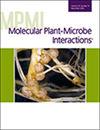求助PDF
{"title":"Molecular Monitoring of Fungicide Resistance in Crop Phytopathogens.","authors":"Katherine G Zulak","doi":"10.1094/MPMI-09-24-0105-FI","DOIUrl":null,"url":null,"abstract":"<p><p>The fight against crop pathogens relies mainly on host genetics and chemistry; however, both areas are compromised by the evolution of resistance in the pathogen population. Fungicide resistance is an ongoing challenge to global food security, as it threatens these important crop protection chemistries. One critical component of resistance management is an effective detection and monitoring program, which needs to be agile, scalable, sensitive, accurate, and cost effective. A rapidly evolving suite of molecular tools are being developed for the detection of fungicide resistance mutations in phytopathogen populations, including high-throughput PCR-based quantitative assays and cutting-edge third-generation DNA sequencing. A single \"silver bullet\" detection technology that will satisfy all study objectives does not exist; thus, every tool has a niche in an integrated detection and monitoring program. This review presents an overview of the rapidly changing landscape of fungicide resistance detection, illustrates how molecular techniques are being exploited to combat fungicide resistance in cereal crop phytopathogens, and highlights challenges and future research directions to aid in the design of effective monitoring systems that aim to apply fungicides strategically and minimize the cost of resistance. [Formula: see text] Copyright © 2025 The Author(s). This is an open access article distributed under the CC BY-NC-ND 4.0 International license.</p>","PeriodicalId":19009,"journal":{"name":"Molecular Plant-microbe Interactions","volume":"38 2","pages":"160-172"},"PeriodicalIF":3.4000,"publicationDate":"2025-03-01","publicationTypes":"Journal Article","fieldsOfStudy":null,"isOpenAccess":false,"openAccessPdf":"","citationCount":"0","resultStr":null,"platform":"Semanticscholar","paperid":null,"PeriodicalName":"Molecular Plant-microbe Interactions","FirstCategoryId":"99","ListUrlMain":"https://doi.org/10.1094/MPMI-09-24-0105-FI","RegionNum":3,"RegionCategory":"生物学","ArticlePicture":[],"TitleCN":null,"AbstractTextCN":null,"PMCID":null,"EPubDate":"2025/4/25 0:00:00","PubModel":"Epub","JCR":"Q2","JCRName":"BIOCHEMISTRY & MOLECULAR BIOLOGY","Score":null,"Total":0}
引用次数: 0
引用
批量引用
Abstract
The fight against crop pathogens relies mainly on host genetics and chemistry; however, both areas are compromised by the evolution of resistance in the pathogen population. Fungicide resistance is an ongoing challenge to global food security, as it threatens these important crop protection chemistries. One critical component of resistance management is an effective detection and monitoring program, which needs to be agile, scalable, sensitive, accurate, and cost effective. A rapidly evolving suite of molecular tools are being developed for the detection of fungicide resistance mutations in phytopathogen populations, including high-throughput PCR-based quantitative assays and cutting-edge third-generation DNA sequencing. A single "silver bullet" detection technology that will satisfy all study objectives does not exist; thus, every tool has a niche in an integrated detection and monitoring program. This review presents an overview of the rapidly changing landscape of fungicide resistance detection, illustrates how molecular techniques are being exploited to combat fungicide resistance in cereal crop phytopathogens, and highlights challenges and future research directions to aid in the design of effective monitoring systems that aim to apply fungicides strategically and minimize the cost of resistance. [Formula: see text] Copyright © 2025 The Author(s). This is an open access article distributed under the CC BY-NC-ND 4.0 International license.
作物病原菌抗杀菌剂的分子监测。
与作物病原体的斗争主要依靠寄主的遗传和化学;然而,这两个地区都受到病原菌种群耐药性进化的影响。杀菌剂耐药性是全球粮食安全面临的一个持续挑战,因为它威胁到这些重要的作物保护化学物质。耐药性管理的一个关键组成部分是有效的检测和监测程序,该程序需要灵活、可扩展、敏感、准确和具有成本效益。目前正在开发一套快速发展的分子工具,用于检测植物病原菌群体中的杀菌剂抗性突变,包括基于高通量pcr的定量分析和尖端的第三代DNA测序。不存在能够满足所有研究目标的单一“银弹”检测技术;因此,每种工具在集成检测和监控程序中都有一席之地。本综述概述了杀菌剂耐药性检测的快速变化,说明了如何利用分子技术来对抗谷物作物植物病原体的杀菌剂耐药性,并强调了挑战和未来的研究方向,以帮助设计有效的监测系统,旨在战略性地应用杀菌剂并最大限度地降低耐药性成本。[公式:见正文]版权所有©2025作者。这是一篇在CC BY-NC-ND 4.0国际许可下发布的开放获取文章。
本文章由计算机程序翻译,如有差异,请以英文原文为准。

 求助内容:
求助内容: 应助结果提醒方式:
应助结果提醒方式:


